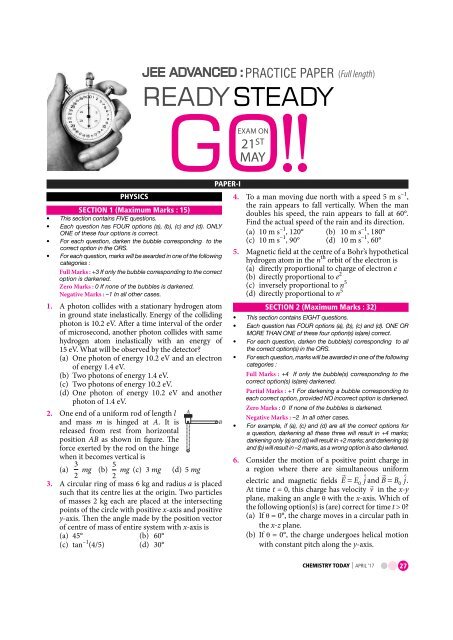Chemistry_Today_April_2017_vk_com_stopthepress
Create successful ePaper yourself
Turn your PDF publications into a flip-book with our unique Google optimized e-Paper software.
(Full length)<br />
PHYSICS<br />
SECTION 1 (Maximum Marks : 15)<br />
• This section contains FIVE questions.<br />
• Each question has FOUR options (a), (b), (c) and (d). ONLY<br />
ONE of these four options is correct.<br />
• For each question, darken the bubble corresponding to the<br />
correct option in the ORS.<br />
• For each question, marks will be awarded in one of the following<br />
categories :<br />
Full Marks : +3 If only the bubble corresponding to the correct<br />
option is darkened.<br />
Zero Marks : 0 If none of the bubbles is darkened.<br />
Negative Marks : –1 In all other cases.<br />
1. A photon collides with a stationary hydrogen atom<br />
in ground state inelastically. Energy of the colliding<br />
photon is 10.2 eV. After a time interval of the order<br />
of microsecond, another photon collides with same<br />
hydrogen atom inelastically with an energy of<br />
15 eV. What will be observed by the detector?<br />
(a) One photon of energy 10.2 eV and an electron<br />
of energy 1.4 eV.<br />
(b) Two photons of energy 1.4 eV.<br />
(c) Two photons of energy 10.2 eV.<br />
(d) One photon of energy 10.2 eV and another<br />
photon of 1.4 eV.<br />
2. One end of a uniform rod of length l<br />
A<br />
and mass m is hinged at A. It is<br />
B<br />
released from rest from horizontal<br />
position AB as shown in figure. The<br />
force exerted by the rod on the hinge<br />
when it be<strong>com</strong>es vertical is<br />
3<br />
(a)<br />
2 mg (b) 5 mg (c) 3 mg (d) 5 mg<br />
2<br />
3. A circular ring of mass 6 kg and radius a is placed<br />
such that its centre lies at the origin. Two particles<br />
of masses 2 kg each are placed at the intersecting<br />
points of the circle with positive x-axis and positive<br />
y-axis. Then the angle made by the position vector<br />
of centre of mass of entire system with x-axis is<br />
(a) 45° (b) 60°<br />
(c) tan –1 (4/5) (d) 30°<br />
PAPER-I<br />
4. To a man moving due north with a speed 5 m s –1 ,<br />
the rain appears to fall vertically. When the man<br />
doubles his speed, the rain appears to fall at 60°.<br />
Find the actual speed of the rain and its direction.<br />
(a) 10 m s –1 , 120° (b) 10 m s –1 , 180°<br />
(c) 10 m s –1 , 90° (d) 10 m s –1 , 60°<br />
5. Magnetic field at the centre of a Bohr’s hypothetical<br />
hydrogen atom in the n th orbit of the electron is<br />
(a) directly proportional to charge of electron e<br />
(b) directly proportional to e 2<br />
(c) inversely proportional to n 5<br />
(d) directly proportional to n 5<br />
SECTION 2 (Maximum Marks : 32)<br />
• This section contains EIGHT questions.<br />
• Each question has FOUR options (a), (b), (c) and (d). ONE OR<br />
MORE THAN ONE of these four option(s) is(are) correct.<br />
• For each question, darken the bubble(s) corresponding to all<br />
the correct option(s) in the ORS.<br />
• For each question, marks will be awarded in one of the following<br />
categories :<br />
Full Marks : +4 If only the bubble(s) corresponding to the<br />
correct option(s) is(are) darkened.<br />
Partial Marks : +1 For darkening a bubble corresponding to<br />
each correct option, provided NO incorrect option is darkened.<br />
Zero Marks : 0 If none of the bubbles is darkened.<br />
Negative Marks : –2 In all other cases.<br />
• For example, if (a), (c) and (d) are all the correct options for<br />
a question, darkening all these three will result in +4 marks;<br />
darkening only (a) and (d) will result in +2 marks; and darkening (a)<br />
and (b) will result in –2 marks, as a wrong option is also darkened.<br />
6. Consider the motion of a positive point charge in<br />
a region where there are simultaneous uniform<br />
electric and magnetic fields ^<br />
E= E j B <br />
0 and = B0<br />
^. j<br />
At time t = 0, this charge has velocity v in the x-y<br />
plane, making an angle θ with the x-axis. Which of<br />
the following option(s) is (are) correct for time t > 0?<br />
(a) If θ = 0°, the charge moves in a circular path in<br />
the x-z plane.<br />
(b) If θ = 0°, the charge undergoes helical motion<br />
with constant pitch along the y-axis.<br />
CHEMISTRY TODAY | APRIL ‘17 27


